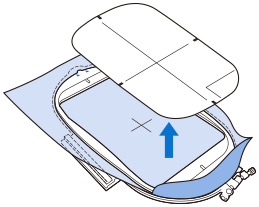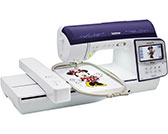Innov-is NQ3600D
FAQs & Troubleshooting |
How do I hoop the fabric in the embroidery frame?
- Use fabrics with a thickness of less than 2 mm (1/16 inch). Using fabrics thicker than 2 mm (1/16 inch) may cause the needle to break.
- Always use a stabilizer material for embroidery when embroidering stretch fabrics, lightweight fabrics, fabrics with a coarse weave, or fabrics which cause pattern shrinkage. Otherwise, the needle may break and cause injury.
-
Press
 (Settings key) to display the settings screen. Display the page with the [Embroidery Foot Height] item by pressing
(Settings key) to display the settings screen. Display the page with the [Embroidery Foot Height] item by pressing  (Previous page key) or
(Previous page key) or  (Next page key). In the [Embroidery Foot Height], use
(Next page key). In the [Embroidery Foot Height], use  and
and  in the settings screen. Adjust the presser foot height for thick or puffy fabrics.
in the settings screen. Adjust the presser foot height for thick or puffy fabrics.
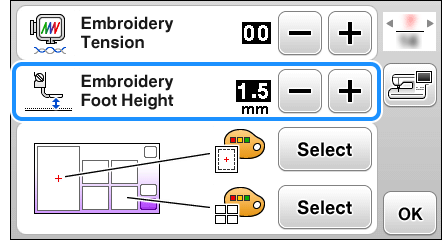
- To increase the space between the presser foot and the needle plate, set the embroidery foot height to a larger number, 1.5 mm setting is used for most embroidery.
- Attaching iron-on stabilizers (backing) to the fabric
- Types of embroidery frames
- Inserting the fabric
- Using the embroidery sheet
Attaching iron-on stabilizers (backing) to the fabric
For best results in your embroidery projects, always use stabilizer material for embroidery.
- Press the iron-on stabilizer material to the wrong side of the fabric.
|
|
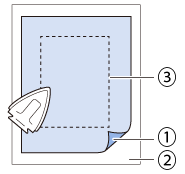 |
(1) Fusible side of stabilizer (2) Fabric (wrong side) (3) Size of the embroidery frame |
-
When embroidering small pieces of fabric that cannot be hooped on an embroidery frame, use stabilizer material as a base. After lightly ironing the fabric to the stabilizer material, hoop it in the embroidery frame. If stabilizer material cannot be ironed onto the fabric, attach it with a basting stitch. After completing the embroidery, remove the stabilizer material carefully.
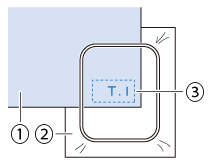
(1) Fabric
(2) Stabilizer
(3) Basting - When embroidering on thin fabrics such as organdy or lawn, or on napped fabrics such as terry cloth or corduroy, use water soluble stabilizer (sold separately) for best results. The water soluble stabilizer material will dissolve completely in water, giving the project a more attractive finish.
- In the case of thick terry cloth towels we recommend that you place a piece of water soluble stabilizer on the top surface of the towel. This will help to reduce the nap of the toweling and result in more attractive embroidery.
- When using fabrics that cannot be ironed (such as terry cloth or fabrics that have loops which expand when ironed) or in places where ironing is difficult, position the stabilizer material under the fabric without fusing it, then position the fabric and stabilizer in the embroidery frame, or check with your authorized Brother dealer for the correct stabilizer to use.
Types of embroidery frames
The types and numbers of supplied embroidery frames will differ depending on the machine model.
Extra Large
-
Embroidery field 26 cm × 16 cm (10 - 1/4 inches × 6 - 1/4 inches)
Use when embroidering connected or combined characters or patterns, or when embroidering large patterns.
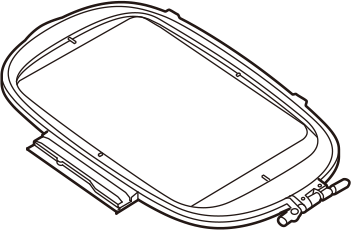
Large (sold separately with some models)
-
Embroidery field 18 cm × 13 cm (7 inches × 5 inches)
Use when embroidering patterns between 10 cm × 10 cm (4 inches × 4 inches) and 18 cm × 13 cm (7 inches × 5 inches).
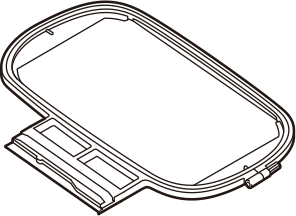
Medium (sold separately with some models)
-
Embroidery field 10 cm × 10 cm (4 inches × 4 inches)
Use when embroidering patterns under 10 cm × 10 cm (4 inches × 4 inches).
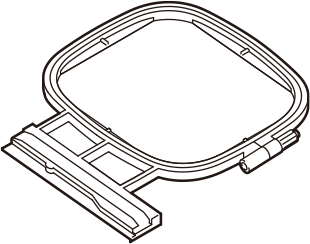
Small (sold separately with some models)
-
Embroidering field 2 cm × 6 cm (1 inch × 2 - 1/2 inches)
Use when embroidering small sized patterns, such as name tags.

Other optional embroidery frames can be used. When choosing frames that do not appear on the screen, be sure to check the design size of the embroidery field of the optional frame. Check with your authorized Brother dealer for frame compatibility.
Select a frame that is slightly larger than the pattern size. Included frame options are displayed on the screen.
 |
(1) Highlighted: Can be used (2) Shaded: Cannot be used |
- If you use a frame that is too small, the presser foot may strike the frame during embroidering and cause injury or may damage your machine.
Inserting the fabric
-
If the fabric is not securely held in the embroidery frame, the embroidery pattern will stitch poorly.
Insert the fabric on a level surface, and gently pull the fabric taut in the frame, being careful not to distort hooped fabric.
-
Lift-up and loosen the frame adjustment screw and remove the inner frame.
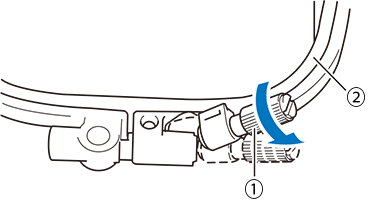
(1) Frame adjustment screw
(2) Inner frame
-
Lay the fabric right side up on top of the outer frame.
Re-insert the inner frame making sure to align the inner frame's with the outer frame's
with the outer frame's  .
.
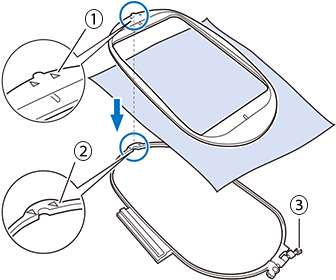
(1) Inner frame's 
(2) Outer frame's
(3) Frame adjustment screw
-
Slightly tighten the frame adjustment screw, and then remove the slack in the fabric by gently pulling on the edges and corners. Do not loosen the screw.
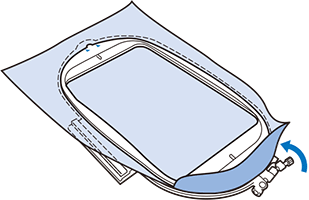
-
Gently stretch the fabric taut, and tighten the frame adjustment screw to keep the fabric from loosening after stretching.
-
After stretching the fabric, make sure the fabric is taut.
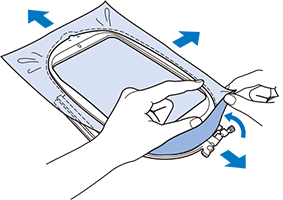
-
Make sure the inside and outside frames are even before you start embroidering.
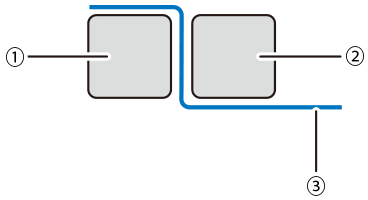
(1) Outer frame
(2) Inner frame
(3) Fabric
- After stretching the fabric, lightly tapping it should produce a drum-like sound.
- Stretch the fabric from all four corners and all four edges. While stretching the fabric, tighten the frame adjustment screw.
-
After stretching the fabric, make sure the fabric is taut.
-
Return the frame adjustment screw to its initial position.
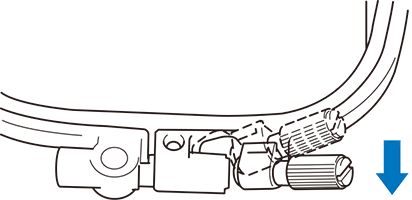
-
You can use the included screwdriver when you loosen or tighten the frame adjustment screw.
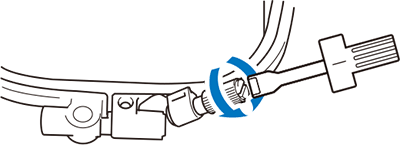
-
You can use the included screwdriver when you loosen or tighten the frame adjustment screw.
Using the embroidery sheet
When you want to embroider the pattern in a particular place, use the embroidery sheet with the frame.
-
With a chalk pencil, mark the area of the fabric you want to embroider.
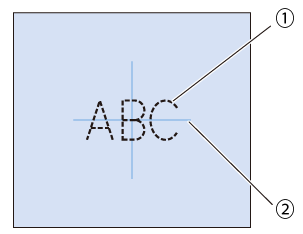
(1) Embroidery pattern
(2) Mark
-
Place the embroidery sheet on the inner frame.
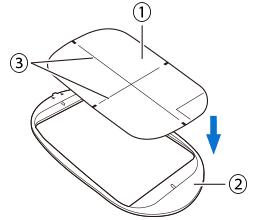
(1) Embroidery sheet
(2) Inner frame
(3) Embroidery sheet base lines
-
Line the mark on the fabric up with the base line on the embroidery sheet.
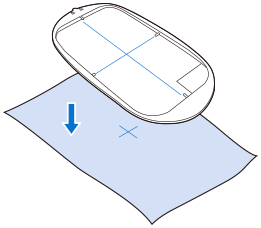
-
Place the inner frame with the fabric on the outer frame and adjust the fabric if needed to align marks on fabric with the embroidery sheet.
-
Remove the embroidery sheet.
